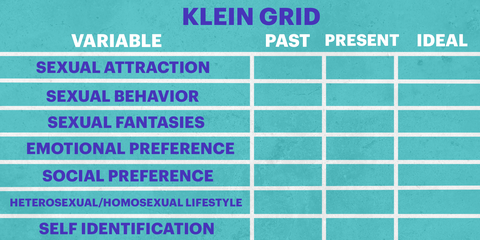Thanks to decades of activism, research, and LGBTQ+ individuals sharing their own lived experiences, it’s become common knowledge that sexuality is a spectrum—or, in other words, less black or white and a little more like a rainbow with infinite shades. There are tons of ways to discover and explore the many hues (so to speak) that exist under the LGBTQ+ umbrella, but one of the earliest metrics popularized was the Kinsey Scale. Chances are, it’s the one you’re most familiar with, too.
The scale was created by biologist Alfred Kinsey in 1948. Kinsey suggested that some individuals might be “exclusively heterosexual” (or a zero on the scale), and others might be “exclusively homosexual” (a six on the scale), but many people fit somewhere between the two numbers. (Editor’s note: The most updated version of the GLAAD Media Reference Guide recommends publications avoid the word “homosexual,” but to describe the Kinsey Scale as accurately as possible, WH felt it necessary to replicate the exact language used in the scale at certain times in this piece.)
At the time, the scale was groundbreaking, and today, it’s still a tool that helps many people realize they might not be “zeroes” or “sixes,” says leading LGBTQ+ expert Dr. Kryss Shane, LSW, LMSW, an adjunct professor and lecturer at the University of Massachusetts, Fordham University, and Columbia University. “The Kinsey Scale often helps individuals who have only ever seen the two extremes of the scale realize that it is not only possible, but also normal to identify as somewhere in the middle of the scale,” Shane explains, adding that it can also be a helpful tool when explaining your identity to a loved one.
Meet the experts:
Kryss Shane, LSW, LMSW, is a leading LGBTQ+ expert and adjunct professor and lecturer at the University of Massachusetts, Fordham University, and Columbia University.
Brendan Zietsch, PhD, is an associate professor at the University of Queensland’s School of Psychology.
That said, there’s no metric or system that can account for every person’s individual identity and capture the beautiful, diverse range of experiences, feelings, and identities out there. “Scales are meant to be a first step, but each person is unique, and each person’s identity is valid,” says Shane.
So what is the scale, exactly, and is it even still relevant today? Ahead, everything to know about the Kinsey Scale’s origins, uses, and shortcomings.
What is the Kinsey Scale?
The full list of numbers is:
- 0: Exclusively heterosexual (that is, attracted to people who don’t share your gender identity)
- 1: Predominantly heterosexual, but occasionally inclined to same-gender attraction
- 2: Predominantly heterosexual, but sometimes inclined to same-gender attraction
- 3: Equally attracted to people who share and people who don’t share your gender identity
- 4: Predominantly homosexual, but sometimes inclined to different-gender attraction
- 5: Predominantly homosexual, but occasionally inclined to different-gender attraction
- 6: Exclusively homosexual (that is, attracted to people who share your gender identity)
- X: No socio-sexual contacts or reactions (a.k.a., asexual—but more on that in a bit)
How does the Kinsey Scale work?
There’s no official test you can take to gauge your “number” on the scale, according to the Kinsey Institute’s website. It’s more of a gut check: The best way to use the Kinsey scale, if you’d like to, is to just choose the number that feels right to you. Your number can also change over time, or even day by day.
Remember, though, there’s no pressure to fit yourself into a category or align perfectly with a number on the scale. The Kinsey scale can certainly help you if you’re struggling to figure out how you identify or trying to put your sexuality into words, but it should never be a be-all, end-all. There are also plenty of issues and limitations with the scale, too—more on that in a bit.
This content is imported from poll. You may be able to find the same content in another format, or you may be able to find more information, at their web site.
What’s the history of the Kinsey Scale?
Alfred Kinsey, along with his colleagues Wardell Pomeroy and Clyde Martin, conceptualized the Kinsey Scale (at the time known as the “Heterosexual-Homosexual Rating Scale”) after interviewing thousands of people about their sexual experiences, desires, and thoughts. They concluded that there were many individuals whose sexualities might not be categorized as “heterosexual” or “homosexual,” and published their findings in the 1948 book Sexual Behavior in the Human Male.
What are some of the limitations of the Kinsey Scale?
At the time of its invention, the Kinsey Scale was groundbreaking simply because it acknowledged identities beyond gay and straight—but it still has limitations and flaws. “The scale is meant to be easy to understand, but in doing so, it lacks much of the nuance that comes with a person’s identity,” says Shane.
Here are just a few of the reasons the Kinsey Scale might not be the most comprehensive or nuanced way to look at attraction.
1. Bisexuality isn’t a halfway point between gay and straight.
The Kinsey Scale places same-gender and different-gender attraction in opposition to each other, Dr. Brendan Zietsch, PhD, an associate professor at the University of Queensland’s School of Psychology, previously wrote in Science. But this isn’t exactly the most accurate way to look at bisexuality and similar sexual orientations.
“The Kinsey Scale is not actually ideal because it implies that there are two poles: attraction to the same sex and attraction to the opposite sex,” Zietsch tells Women’s Health. “But they’re on the same scale, which implies that as you go away from one, you go towards the other.” This also implies that someone who’s a Kinsey “three,” for example, is just “moderately attracted to both sexes.” For many people who experience attraction to people of several (or all!) genders—including those who are bisexual, pansexual, or otherwise nonmonosexual—this isn’t the case at all.
2. The scale doesn’t account for people on the asexual spectrum.
“The conception also ignores asexual people who aren’t attracted to either sex,” Zietsch says. And although there’s an “X” identifier for people who have no sexual feelings, individuals on the asexual spectrum can be gay, straight, bi, or any other identity, because sexual attraction is only one type of attraction. Which brings us to…
3. Sexual and romantic attraction can differ.
The Kinsey Scale was conceptualized after Kinsey and his colleagues studied participants’ sexual behavior, thoughts, and histories. But it’s possible to be aromantic and bisexual, for example, or asexual and panromantic. Your sexual history, sexual desires, and romantic, crush-like feelings might not all check the same boxes, or align with the same “number” on the Kinsey scale.
Are there any alternatives to the Kinsey Scale?
According to Zietsch, the simplest fix would be to measure same-gender sexual attraction and different-gender attraction in two different, side-by-side scales. “[It would] allow people to either say I’m not attracted to either, or I’m attracted to both, or anywhere in between,” he says.
The American Institute of Bisexuality, meanwhile, suggests the Klein Grid, which “captures more nuance and complexity than the familiar, one-dimensional Kinsey Scale.” The grid, first created by Dr. Fritz Klein and published in 1978’s The Bisexual Option, uses the same numbers as the Kinsey Scale. But unlike the scale, it accounts for seven different variables, including sexual attraction, sexual behavior, and emotional attraction. For each variable, people can also provide three answers: one describing their history, one describing their present, and one describing their future.
Ultimately, however, none of these systems can perfectly encapsulate the nuances of every sexuality and every experience. “Often, we seek out easy-to-understand guidance because no one wants to feel complicated or alone in their experience,” says Shane. This causes people to fit themselves into labels (or, in this case, numbers) even when they aren’t quite right.
“Just like we can find clothing off the rack that mostly fits, many of us settle for this and just deal with the aspects that aren’t quite right for our bodies,” Shane continues. “Gender and sexuality and identity are much more like tailored clothing—individual to each of our individual selves.”
Lydia Wang is the love & life editor at Women’s Health, where she writes and edits articles about sex, relationships, and pop culture. She lives in New York and spends way too much of her free time reading romance novels in coffee shops and tweeting about her favorite dating shows.










